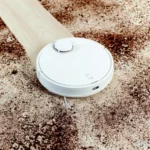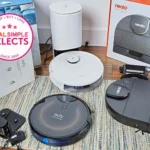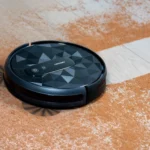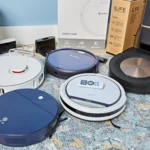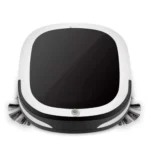Imagine coming back to a clean home after a long day at work without ever lifting a finger to tidy up – this is exactly what a smart vacuum cleaner can do for you! However, with so many options available on the market, it can be perplexing to find the perfect one for your space. One important aspect to consider is the design of the vacuum cleaner, as it can directly impact its efficiency. In this article, we will explore how factors such as suction power, dustbin size, battery life, and navigation system, as well as design elements like shape and size, brushes, filtration system, and noise reduction, can all affect the performance of your smart vacuum cleaner. Additionally, we’ll cover the cleaning performance and maintenance of these devices, including surface type, dustbin emptying, filter replacement, and brush maintenance. By examining all of these aspects, you can make a more informed decision about which smart vacuum cleaner to invest in for a tidier and more stress-free home.
Factors Affecting Efficiency
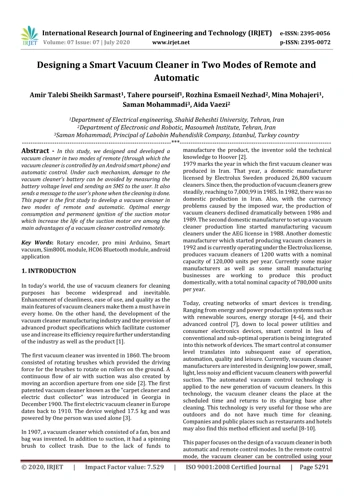
When it comes to smart vacuum cleaners, their efficiency can greatly affect how well they clean your home. There are several factors that play a significant role in optimizing the performance of your smart vacuum cleaner. These include suction power, dustbin size, battery life, and navigation system. Each of these factors can impact the vacuum’s ability to clean effectively and efficiently. For instance, a smart vacuum cleaner with a short battery life will not clean as many rooms as one with a longer battery life. To learn more about how to extend the battery life of your smart vacuum, keep reading this article.
Suction Power
One of the most important factors to consider when it comes to the efficiency of a smart vacuum cleaner is its suction power. A vacuum’s suction power determines how well it can pick up dirt and debris from various surfaces. The higher the suction power, the better the cleaning performance will be.
Suction power is measured in Pascals (Pa), which is a unit of pressure. The higher the number of Pascals, the more powerful the suction of the vacuum. Typically, smart vacuums have a suction power between 1200 Pa to 2200 Pa.
However, it’s important to note that suction power alone is not the only factor that determines a smart vacuum’s cleaning performance. Other factors such as the dustbin size, battery life, and navigation system also play an important role.
To ensure that your smart vacuum cleaner has a strong suction power, consider investing in a model with a high-powered motor and advanced suction technology. You can compare different models based on their suction power by looking at their product specifications.
Comparison of Smart Vacuums Based on Suction Power
| Model | Suction Power (Pa) |
|---|---|
| Smart Vacuum A | 1800 |
| Smart Vacuum B | 2000 |
| Smart Vacuum C | 2200 |
It’s important to note that higher suction power often results in higher energy consumption and lower battery life. You’ll need to balance the power and battery life when choosing a smart vacuum cleaner. You can learn more about how to extend your smart vacuum’s battery life by checking out our article on how to extend the battery life of your smart vacuum.
Dustbin Size
The dustbin size is an equally important factor in determining the efficiency of a smart vacuum cleaner. The amount of space it has to fill before you need to empty it is an important consideration when purchasing a robotic vacuum. Having a dustbin that is too small might mean more frequent interruptions during the cleaning process. If it’s too large, it might add to the bulk of the device and make it hard to maneuver.
The size of the dustbin is influenced by the size of the vacuum and its specific design. If you have a larger home or a space that requires a lot of cleaning, it’s worth considering a larger dustbin size. This will reduce the time you spend emptying the bin and allow the vacuum to work for longer periods uninterrupted.
The dustbin size and the battery life of your smart vacuum are closely interlinked. A larger dustbin will require more power to operate, and this may have an impact on the battery life. You need to consider the vacuum’s maximum run time and how frequently it needs to be recharged. On machines with smaller bins, regular emptying might be needed to avoid overloading the motor, leading to power consumption inefficiency.
The dustbin size also determines the type of debris that the vacuum can accommodate. If you have pets or prone to allergies, a vacuum with a larger dustbin and a high-efficiency particulate air (HEPA) filter may be your best bet. HEPA filters are specifically designed to trap the smallest of allergen particles, ensuring that the air you breathe is clean.
For efficient cleaning and maintenance, the dustbin size and cleaning frequency must balance. A larger bin requires less frequent cleaning, but waiting too long before cleaning it can lead to clogging or reduced suction power. A smaller bin might need to be emptied several times during cleaning, but the vacuum can run for extended periods.
Remember that when choosing a vacuum, the dustbin size is an important consideration. Ensure that the size adequately suits your cleaning needs and is in sync with the vacuum’s cleaning ability for efficient and stress-free cleaning experience.
Link: Battery type and capacity in smart vacuums.
Battery Life
One of the crucial factors affecting the efficiency of a smart vacuum cleaner is the battery life. It determines how long the cleaner can operate on a single charge and how much area it can cover. When choosing a smart vacuum cleaner, it is essential to consider the battery life so that it can meet your cleaning needs without requiring frequent charging.
Here are some points to consider when it comes to battery life:
- Battery Capacity: The capacity of the battery determines how long the cleaner will run on a single charge. The higher the battery capacity, the longer the vacuum run time will be.
- Battery Type: Smart vacuum cleaners usually utilize lithium-ion batteries for their long-lasting and efficient operation. These batteries are also lightweight, which makes them ideal for smart vacuums.
- Battery Charge Time: The charge time of a battery is also an essential factor to consider. The charge time can vary depending on the battery capacity and type, so make sure to check the manufacturer’s specifications before making a purchase.
- Battery Replacement: It is important to know if the battery can be replaced in case it degrades over time. Some smart vacuum cleaners allow battery replacement, which can save you money in the long run, while others do not.
Keeping these points in mind, one can make an informed decision while selecting a smart vacuum cleaner that can handle their cleaning needs. Having a robust battery life in your smart vacuum cleaner will make sure that it can cover large areas without needing frequent charging. A longer battery life also means less interruption during cleaning, resulting in increased efficiency.
To learn more about how the design of smart vacuums can affect their battery life, check out our detailed article on design principles that influence battery life of smart vacuums.
Navigation System
A good navigation system is crucial for the efficiency of a smart vacuum cleaner. It allows the device to move around freely, avoiding obstacles, and adjusting to different cleaning surfaces. There are a variety of navigation systems available, each with its strengths and weaknesses.
1. Camera-Based Navigation: This navigation system utilizes cameras placed at the top of the vacuum cleaner to take images of the surrounding area. The device then uses this information to map out the cleaning area and avoid obstacles. The downside of this system is that it requires good lighting and can struggle in low light conditions.
2. Laser-Based Navigation: This navigation system uses lasers to create a 3D map of the cleaning area. This technology is incredibly accurate and can even detect small obstacles like power cords. However, the downside is that it can be expensive to produce and may increase the cost of the vacuum cleaner.
3. Sensor-Based Navigation: This navigation system uses a variety of sensors to detect obstacles and navigate around them. It can detect furniture and even stairs, ensuring that the vacuum cleaner does not fall off an edge. The challenge with this system is that the sensors must be well-designed and positioned to work effectively.
Whatever the navigation system used, it must be able to map out the cleaning area and move accordingly. It should also be able to avoid obstacles and adjust its cleaning pattern accordingly. A good navigation system is vital to the efficiency of a smart vacuum cleaner, allowing it to produce a thorough clean with minimal effort.
How Design Affects Efficiency
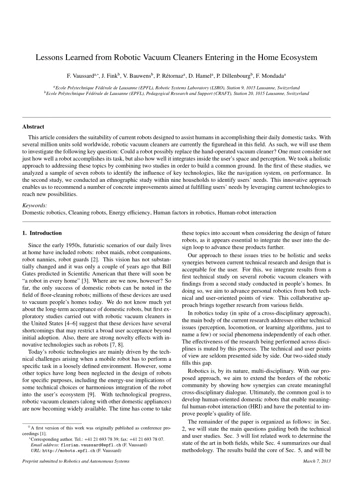
When it comes to smart vacuum cleaners, their design plays a crucial role in determining their efficiency levels. The design elements incorporated into these devices can make all the difference in terms of suction power, dustbin capacity, battery life, navigation, and cleaning performance. In this section, we’ll explore the various ways in which the design of a smart vacuum cleaner can impact its overall efficiency. From the shape and size of the device to the type of brushes and filtration systems used, everything matters. So, let’s dive in and see how design influences the performance of your smart vacuum cleaner.
Shape and Size
The shape and size of your smart vacuum cleaner are crucial factors that can seriously affect its efficiency. A well-designed smart vacuum cleaner not only looks sleek and modern, but it is also ergonomically optimized for cleaning different types of floors and spaces.
Shape: The shape of your smart vacuum cleaner can make a huge difference in its ability to clean different types of spaces. For instance, a robot vacuum cleaner with a compact circular shape can easily navigate around tight corners and obstacles, whereas, a D-shaped smart vacuum cleaner can easily clean hard-to-reach corners and edges, and along walls. A stick vacuum cleaner, on the other hand, is generally tall and slender, making it easier to store in smaller spaces.
Size: Size is another crucial aspect when it comes to smart vacuum cleaners as it affects the cleaning coverage and battery life. A smaller and lighter vacuum cleaner may have a shorter battery life and coverage but it is easier to maneuver around the house, especially in tight spaces. Conversely, larger and heavier vacuum cleaners have longer battery life and coverage but can be more cumbersome and less effective at getting into tough areas.
The table below shows some examples of popular smart vacuum cleaners and their corresponding shapes and sizes:
| Smart Vacuum Cleaner | Shape | Size (Height x Diameter) |
|---|---|---|
| iRobot Roomba 690 | Circular | 3.6 inches x 13 inches |
| Xiaomi Mi Robot Vacuum | Circular | 3.8 inches x 13.6 inches |
| Shark Rocket Corded Hand Vac | Stick | 13 inches x 10 inches |
| Dyson Cyclone V10 Absolute | Stick | 49.2 inches x 9.8 inches |
| Neato Botvac D7 Connected | D-shaped | 3.9 inches x 12.7 inches |
Ultimately, the shape and size of a smart vacuum cleaner will depend on your cleaning needs and preferences. Consider the size of your home, the type of floors and furniture you have, and where you need to clean before choosing the best vacuum cleaner for you. With the right shape and size, you can maximize the efficiency of your smart vacuum cleaner and achieve a cleaner home with less effort.
Brushes
One of the most critical components that determine the efficiency of a smart vacuum cleaner is the brushes used in its design. The brushes play a crucial role in ensuring that the vacuum cleaner can pick up dust, dirt, and debris from different types of surfaces.
There are several types of brushes available in the market today, and each has unique features and benefits. The following table highlights some of the most common types of brushes used in smart vacuum cleaners, their features, and benefits:
| Types of Brushes | Features | Benefits |
|---|---|---|
| Bristle Brush | Uses bristles to agitate and pick up dirt and debris | Effective at deep-cleaning carpets and removing pet hair |
| Rubber Brush | Uses rubber blades to clean hard surfaces and carpets | Effective at picking up pet hair and fine dust particles |
| Combo Brush | Uses both bristles and rubber blades to clean different surfaces | Offers versatile cleaning performance on both carpets and hard floors |
| Tangle-Free Brush | Uses rubber rollers to prevent hair tangles and clogs | Offers maintenance-free operation and efficient cleaning performance |
It is essential to choose the right type of brush based on your cleaning needs and the surface types in your home. For example, if you have pets, a bristle brush might be a better choice as it can effectively pick up pet hair from carpets. On the other hand, a rubber brush might be more suitable for hard floors as it can prevent scratches and scuffs.
Regular maintenance of the brushes is also essential to ensure their efficient performance. This may include cleaning them regularly to remove debris and replacing them when necessary as they wear out over time. By paying attention to the type of brushes and their maintenance, you can ensure that your smart vacuum cleaner delivers its optimum cleaning performance.
Filtration System
When it comes to smart vacuum cleaners, the Filtration System plays a crucial role in ensuring that the surrounding air remains clean and healthy to breathe. A high-quality filtration system can efficiently trap and contain harmful allergens, dust, and dirt particles, which is especially important for those suffering from allergies or respiratory issues.
There are various types of filtration systems used in smart vacuums, each with its own set of benefits and drawbacks. Let’s take a look at some of the most common filtration systems found in modern smart vacuums.
| Filtration System | Description | Pros | Cons |
|---|---|---|---|
| HEPA | High-efficiency particulate air filter that captures particles as small as 0.3 microns. | – Effective at removing allergens and pollutants – Helps eliminate unpleasant odors – Ideal for people with allergies or asthma |
– Can be expensive – Requires frequent filter replacements |
| Cyclonic | Uses centrifugal force to separate dirt and debris from the air. | – Does not require filter replacements – Good for trapping large debris |
– Not as effective at trapping fine particles – Can emit some dust back into the air during emptying |
| UV-C | Uses ultraviolet light to kill bacteria, viruses, and other microorganisms. | – Helps eliminate harmful microorganisms – Good for eliminating odors |
– Not as effective at trapping particulate matter – Can be expensive |
As you can see, each filtration system has its own strengths and weaknesses. The HEPA filtration system is often considered to be the gold standard in terms of air filtration, but it can be expensive and requires frequent filter replacements. Cyclonic filters, on the other hand, do not require filter replacements but may not be as effective at trapping fine particles.
When choosing a smart vacuum, it’s important to consider the filtration system and determine which one will best suit your needs. If you or anyone in your household suffers from allergies or respiratory issues, a HEPA filter may be the best choice. However, if you’re looking for a low-maintenance option, a cyclonic filter may be more suitable.
The filtration system is a crucial component of any smart vacuum cleaner, and it’s important to choose a system that will efficiently trap harmful particles while keeping the air clean and healthy to breathe.
Noise Reduction
One important factor in the design of a smart vacuum cleaner that can impact its efficiency is noise reduction. A noisy vacuum cleaner may be annoying to use and may even disturb other activities while in use. That’s why noise reduction is an important consideration for many users. Here are some design features that can help to reduce noise in a smart vacuum cleaner:
- Brushless motor: The first step in noise reduction is to use a brushless motor. This type of motor is quieter than traditional motors, which are likely to emit a loud noise during operation.
- Sound insulation: Another way to reduce the noise in a smart vacuum cleaner is to use sound insulation material around the motor area. This can help to absorb the noise and prevent it from escaping to the environment.
- Variable suction: Some smart vacuum cleaners come with a variable suction feature that allows you to adjust the suction power based on the surface you’re vacuuming. Reducing the suction power can also help to reduce the noise level of the vacuum cleaner.
- Low-decibel operation: To ensure that the noise is always at a minimum, some smart vacuum cleaners are designed to operate at a low-decibel level. This feature is particularly helpful when using the vacuum cleaner in large, open spaces, as the sound will be less intrusive.
- Noise optimization: The smart vacuum cleaner’s design can also affect the noise level. For instance, some models may have a sleeker design that allows for smoother airflow and reduced noise. Alternatively, some models may feature anti-vibration technology that can mitigate vibrations and noise.
Noise reduction is an essential consideration when designing a smart vacuum cleaner. By using a brushless motor, insulation material, variable suction, low-decibel operation, and taking into account noise optimization, the vacuum cleaner can offer a quiet operation that is both efficient and user-friendly.
Cleaning Performance and Maintenance
Keeping your smart vacuum cleaner in top condition is crucial for its efficacy and longevity. After all, regular cleaning and maintenance not only ensures optimal cleaning performance, but it also prolongs the lifespan of the device. In this section, we will delve into the nitty-gritty of cleaning performance and maintenance, exploring the key factors that affect the functionality of your device, such as surface type and dustbin emptying. We will also discuss the maintenance tasks that you need to carry out to keep your smart vacuum cleaner in excellent working order, including filter replacement and brush maintenance. So, let’s roll up our sleeves and get down to the cleaning business!
Surface Type
When it comes to the cleaning performance of a smart vacuum cleaner, the surface type plays a vital role. Different surfaces require different types of brushes and suction power to achieve optimal results. Here are the different types of surfaces and the suitable cleaning performance to consider:
1. Hard floors: Hard floors such as wood, tile or linoleum are among the easiest surfaces to clean with a smart vacuum cleaner. A model with a brushroll that has a soft touch or no brush at all is best suited for these surfaces as it can pick up dust and debris without scratching the floors.
2. Low pile carpets: A low pile carpet has shorter fibers, making them easier to clean than high pile carpets. A smart vacuum cleaner with a rotating brush is ideal for cleaning low pile carpets as it can dislodge dirt and pet hair trapped in between the fibers.
3. High pile carpets: High pile carpets have longer fibers, making them harder to clean. A smart vacuum cleaner with a strong suction power is recommended for deep cleaning high pile carpets. It should also have bristle brushes that can agitate the fibers to release dirt and debris.
4. Furniture: Some smart vacuum cleaners come with attachments that allow them to clean furniture, such as sofas or curtains. These attachments have a soft brush that is gentle on the fabric to avoid damage.
It is essential to choose a smart vacuum cleaner that can handle your specific surface type to ensure optimal cleaning performance. Neglecting to do so can result in a poorly cleaned surface and even damage to your floors or furniture.
Dustbin Emptying
Keeping the dustbin empty is essential for optimal performance and maintaining the efficiency of your smart vacuum cleaner. A full dustbin can lead to reduced suction power, causing your cleaner to leave some debris and dirt behind.
The frequency of dustbin emptying will depend on its size, cleaning frequency, and the amount of debris and dirt your vacuum cleaner picks up. Most of the dustbins in smart vacuum cleaners are relatively small in size, ranging from 0.3L to 0.7L. However, some larger models come with larger dustbins up to 1L to reduce the need for frequent emptying.
It is important to note that how often you should empty the dustbin will depend on how much dust, dirt, and debris you are cleaning up. If you are living in a heavily trafficked home with pets, kids or tracking in outdoor debris, you will likely have to empty the dustbin more often. Emptying the dustbin after each cleaning cycle will prevent any buildup of dirt and ensure better cleaning results.
Dustbin emptying is easy and straightforward. You need to remove the dustbin from your vacuum cleaner, and you can empty the contents directly into a waste bin or trashcan. Make sure to dispose of the debris properly and avoid touching any dust or dirt that may have collected on the surfaces of the dustbin. Dustbin emptying should be done outside or over a sink or large garbage can to avoid any dust and debris from falling onto the floor and making more of a mess.
The frequency of cleaning and emptying the dustbin regularly is vital to maintain the efficiency of your smart vacuum cleaner. If you don’t empty the dustbin regularly, it may lead to the debris and dirt building up, causing a reduction in suction power and cleaning efficiency, ultimately reducing cleaning performance.
Make sure to follow the manufacturer’s instructions on how to empty the dustbin and clean it after each use. This will ensure that your smart vacuum cleaner is always in good condition and will provide high-performance cleaning every time you use it.
Below is a table summarizing the importance of regular dustbin emptying for the efficiency of your smart vacuum cleaner:
| Importance of Regular Dustbin Emptying |
|---|
| Reduces debris and dirt buildup |
| Prevents a reduction in suction power and cleaning efficiency |
| Ensures better cleaning results |
| Helps maintain the smart vacuum cleaner’s cleaning performance and efficiency |
Filter Replacement
Maintaining proper filter replacement is crucial for the efficient operation of your smart vacuum cleaner. The vacuum’s filtration system plays an essential role in capturing dust, allergens, and other debris from the air, preventing them from circulating back into your indoor environment. Over time, the filter may become clogged and less effective at capturing these particles, which can negatively impact the machine’s suction power and cleaning performance.
To ensure your vacuum operates at its best, you must regularly check and replace the filter as needed. The frequency of filter replacement may vary depending on factors such as usage frequency, the presence of pets or dusty environments, and the type of filter used. Check the manufacturer’s instructions for recommended replacement schedules.
When selecting replacement filters for your vacuum, consider the quality and compatibility of the filter with your machine. Some models may require specific types of filters, and using the wrong filter may cause damage to the vacuum or reduce its effectiveness.
To properly replace your vacuum’s filter, follow these steps:
- Power off the vacuum: Before beginning any maintenance procedures, always turn off and unplug your vacuum to prevent electric shock or injury.
- Locate the filter: The filter is typically located near the dustbin, either on the side or under a cover. Refer to your vacuum’s user manual for detailed instructions on the filter’s location and removal.
- Remove the filter: Depending on the model, the filter may slide out or may require unscrewing a cover. Carefully remove the filter and dispose of it if it is disposable. For reusable filters, clean them according to the manufacturer’s instructions.
- Install the new filter: Insert the new filter into the same location as the old filter. Ensure it is properly aligned and secured, either by snapping it into place or screwing on the cover, depending on the model.
- Turn on the vacuum: Once the new filter is properly installed, turn on the vacuum and test its suction power and cleaning performance.
By taking care of your vacuum’s filter replacement, you can help ensure its longevity, maintain its efficiency, and promote a clean and healthy indoor environment.
Brush Maintenance
Keeping the brushes of your smart vacuum cleaner in top condition is crucial for maintaining its efficiency. Over time, hair, dust, and other debris can get tangled in the brushes, reducing their effectiveness. That’s why it’s important to perform regular brush maintenance to ensure optimal performance. Here are some tips to help you keep your vacuum’s brushes in tip-top shape:
| TIP | DESCRIPTION |
| 1 | Remove any large debris from the brushes using a pair of scissors or a brush |
| 2 | Clean the brushes with a damp cloth or brush |
| 3 | Check the brushes for damage or wear and replace them if necessary |
| 4 | Make sure the brushes are properly aligned and securely attached to the vacuum cleaner |
| 5 | Consider upgrading to high-performance brushes for improved cleaning efficiency |
By following these simple tips, you can help ensure that your smart vacuum cleaner is always performing at its best. Regular brush maintenance will not only help keep your floors cleaner, but it will also extend the life of your vacuum cleaner, saving you money in the long run. So don’t neglect this important aspect of vacuum maintenance and enjoy the full benefits of your smart vacuum for years to come.
Conclusion
After researching and analyzing the impact of design on the efficiency of smart vacuum cleaners, it is clear that a well-designed vacuum can have a significant impact on its performance. The suction power, dustbin size, battery life, and navigation system are all important factors that affect efficiency. However, the design of a vacuum also plays a crucial role.
The shape and size of a vacuum can affect its ability to reach certain areas and clean efficiently. The use of specialized brushes can greatly enhance the cleaning performance, while a filtration system can improve air quality in your home. Furthermore, noise reduction measures can make the vacuum more tolerable to use.
When it comes to cleaning performance and maintenance, the type of surfaces being cleaned, dustbin emptying, filter replacement, and brush maintenance are all important considerations. Overall, regular maintenance is essential to keep your vacuum operating at peak efficiency.
In conclusion, investing in a well-designed smart vacuum cleaner can make a significant difference in its performance and efficiency. By taking into account the various factors that affect efficiency and design features, you can choose a vacuum that will make your cleaning tasks easier and more effective. Keep in mind that regular maintenance and upkeep are crucial to ensure that your vacuum continues to operate at its best. So, choose wisely and enjoy a cleaner home with a smart vacuum cleaner designed with efficiency in mind.
Frequently Asked Questions
Can the design of a smart vacuum cleaner impact its suction power?
Yes, the shape and size of the vacuum cleaner can affect its suction power. A compact design may limit the space for a motor and restrict the power output, while a larger design may allow for a more powerful motor.
Is a larger dustbin size always better for a smart vacuum cleaner?
Not necessarily. While a larger dustbin can hold more dirt and debris, it can also add weight to the vacuum cleaner and affect its maneuverability. It’s important to find a balance between dustbin size and ease of use.
How important is battery life for a smart vacuum cleaner?
Battery life is crucial for a smart vacuum cleaner, as it determines how long the device can operate before needing to recharge. A longer battery life can ensure more efficient cleaning without interruptions.
What is the impact of a navigation system on a smart vacuum cleaner?
A navigation system helps the vacuum cleaner move around obstacles and avoid collisions. This can improve the efficiency of cleaning and reduce the risk of damage to the device.
Can the shape and size of a smart vacuum cleaner affect its cleaning performance?
Yes, the shape and size of a smart vacuum cleaner can impact its ability to reach tight spaces, corners, and under furniture. A sleek design can improve maneuverability and access to hard-to-reach areas.
Are brushes important for a smart vacuum cleaner?
Yes, brushes play a crucial role in cleaning. They help to agitate dirt and debris, loosen pet hair, and lift dust off of surfaces.
How does a filtration system affect a smart vacuum cleaner’s efficiency?
A filtration system can impact the efficiency of cleaning by capturing even the smallest particles of dust and dirt. A highly effective filtration system can prevent allergens from being released back into the air, improving the air quality in your home.
How can noise reduction impact the performance of a smart vacuum cleaner?
Noise reduction can improve the overall experience of using a smart vacuum cleaner by making it more comfortable to be around. Additionally, it can help reduce stress on pets and children who may be disturbed by loud noises.
Can the surface type impact a smart vacuum cleaner’s cleaning performance?
Yes, different surfaces can require different suction power, brush types, and cleaning modes. Carpeted areas may require a more powerful motor and specialized brushes, while hardwood floors may require a gentle touch to prevent scratches.
How often should a smart vacuum cleaner’s filter be replaced?
It’s recommended to replace the filter of a smart vacuum cleaner every 3-6 months, depending on usage. This ensures that the filtration system is functioning optimally and preventing allergens from being released back into the air.


